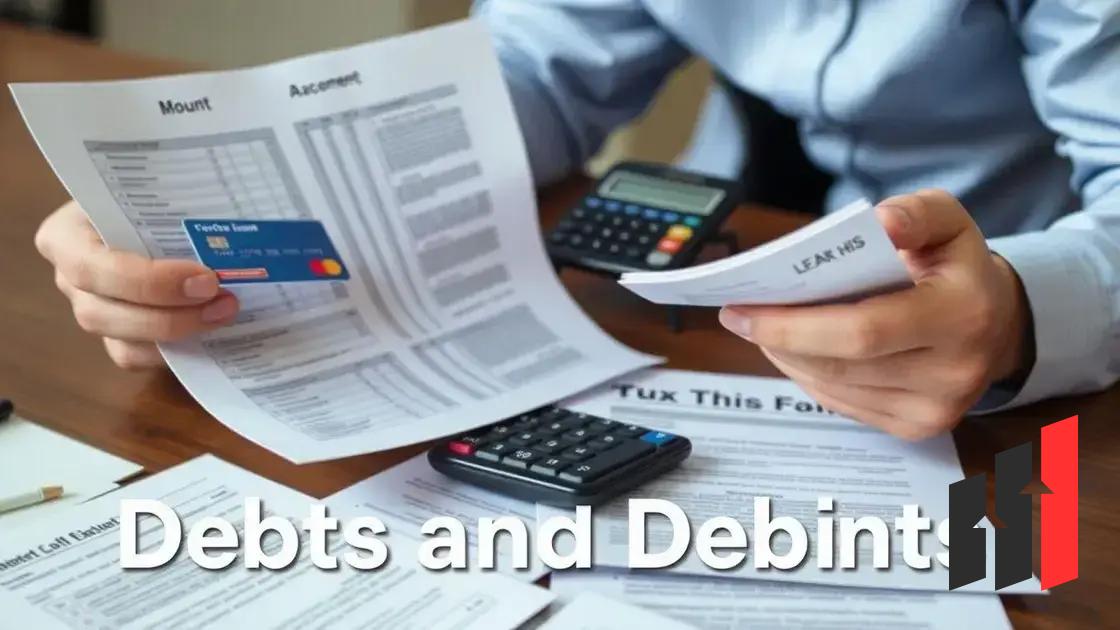The difference between assets and liabilities is that assets are valuable resources you own that generate income or appreciate, while liabilities are debts or financial obligations that require repayment and can reduce your net worth.
The difference between assets and liabilities might seem like finance jargon, but it’s key to managing your money well. Ever wondered why your net worth doesn’t grow despite having things of value? Let’s explore what sets these two apart and how that affects your wallet.
Understanding what assets really are
Assets are valuable resources that you own and can use to generate income or provide future benefits. They come in various forms such as cash, property, investments, and equipment. Understanding what assets really are helps you see how they contribute to building wealth and improving financial stability.
There are two main types of assets: current assets and fixed assets. Current assets include cash or items that can quickly be converted to cash, like accounts receivable and inventory. Fixed assets, on the other hand, are long-term resources like buildings, land, and machinery that you use over time.
Assets are important because they can increase your net worth. For example, owning a house or investment portfolio represents assets that can grow in value or provide income through rent or dividends. Even a savings account is an asset since it holds your money securely and earns interest.
Why Assets Matter
Having more assets means you have more resources to cover expenses, invest in opportunities, or handle emergencies. Assets can also be used as collateral to secure loans, making them vital for expanding your financial possibilities.
In personal finance, tracking your assets gives you a clearer picture of your financial health. A higher asset base generally indicates stronger financial footing and increased ability to meet financial goals.
Liabilities explained: what you owe

Liabilities represent what you owe to others and are debts or financial obligations that you must repay. These can include loans, credit card balances, mortgages, and unpaid bills. Understanding liabilities is important because they affect your financial stability and must be managed carefully.
There are two main types of liabilities: current liabilities and long-term liabilities. Current liabilities are debts that need to be paid within a year, like utility bills or credit card payments. Long-term liabilities, such as mortgages or student loans, are due over a longer period.
How Liabilities Impact Your Finances
When your liabilities grow larger than your assets, it may lead to financial stress or reduced creditworthiness. It’s essential to keep track of your debts and plan repayments to avoid penalties and higher interest rates.
Managing liabilities well means prioritizing high-interest debts and making consistent payments. By reducing liabilities, you free up more resources for savings and investments, improving your overall financial health.
Remember, not all liabilities are bad. Some, like a mortgage on a home, can be considered an investment if the property grows in value over time. However, balancing liabilities with assets is key.
How to distinguish assets from liabilities
Distinguishing between assets and liabilities is essential for understanding your true financial position. Assets are items you own that hold value or generate income. In contrast, liabilities are debts or obligations you owe to others.
One simple way to tell them apart is by asking: does this item bring money in or take money out? For example, rental property that generates monthly income is an asset. A car loan that requires monthly payments is a liability.
Key Questions to Identify Assets vs Liabilities
- Does it put money in your pocket regularly or increase in value? (Asset)
- Does it cost money regularly or lose value over time? (Liability)
- Can it be sold or used to secure credit? (Asset)
- Is it an obligation that must be repaid? (Liability)
It’s also helpful to classify them by liquidity and duration. Current assets and current liabilities are short-term and affect daily cash flow, while fixed assets and long-term liabilities have longer impacts.
Understanding these distinctions helps you manage your finances better and make smarter decisions to grow your net worth.
Why knowing the difference affects your money

Knowing the difference between assets and liabilities is crucial because it directly impacts your financial health and decision-making. When you understand which items in your life increase your wealth and which drain your resources, you can make smarter choices about spending, saving, and investing.
Assets add value by generating income or appreciating over time. Liabilities, however, require payments and often come with interest, cutting into your cash flow. Misunderstanding these can lead to poor financial habits, such as taking on too much debt or failing to build valuable resources.
How This Knowledge Influences Your Money
- Better budgeting: You can allocate funds more effectively by prioritizing asset-building and managing liabilities.
- Increased net worth: Focusing on acquiring assets rather than liabilities helps grow your overall wealth.
- Improved credit score: Managing liabilities well prevents missed payments and keeps your credit healthy.
- More financial security: Strong asset bases cushion against unexpected expenses and economic shifts.
Understanding the difference also helps in planning your financial future. It guides you in setting goals, such as buying property, reducing debts, or investing in education, that lead to financial independence.
Tips to manage assets and liabilities wisely
Managing assets and liabilities wisely is key to maintaining financial balance and growing wealth over time. Start by tracking both carefully to know exactly what you own and owe. This helps you make informed decisions about spending and saving.
Organize Your Finances
Create a detailed list of your assets, including savings, investments, and property. Similarly, list your liabilities such as loans, credit card debts, and other obligations. Regularly updating these lists helps spot opportunities to increase assets or reduce liabilities.
Prioritize High-Interest Liabilities
Focus on paying down debts with the highest interest rates first. This strategy reduces the amount you pay over time and frees up money to invest in building assets.
Build Assets That Generate Income
Invest in assets that offer steady returns, like rental properties, stocks that pay dividends, or businesses. Income-generating assets can help cover liabilities and grow your net worth.
Create an Emergency Fund
Set aside cash reserves to cover unexpected expenses. This prevents you from relying on high-interest debt and preserves your financial stability.
Review and Adjust Regularly
Your financial situation evolves, so it’s important to review your assets and liabilities periodically. Adjust your strategies as needed to keep improving your financial health.
Understanding assets and liabilities is key to smart money management
Knowing the difference between assets and liabilities helps you make better financial choices every day. By focusing on building assets and managing liabilities carefully, you can grow your wealth and secure your financial future.
Regularly reviewing your finances, prioritizing debt repayment, and investing in income-generating assets are simple yet effective steps anyone can take. These habits improve your net worth and provide stability during unexpected changes.
Ultimately, managing your assets and liabilities wisely puts you in control of your money and helps you achieve your financial goals with confidence.
FAQ – Understanding assets and liabilities
What is the main difference between assets and liabilities?
Assets are things you own that have value or generate income, while liabilities are debts or obligations you owe to others.
Why is it important to know the difference between assets and liabilities?
Knowing the difference helps you manage your money better, build wealth, and avoid financial problems by making smarter decisions.
Can a liability ever be considered a good thing?
Yes, some liabilities like a mortgage on an appreciating home can be considered good if they help you build valuable assets over time.
How can I start managing my liabilities wisely?
Focus on paying off high-interest debts first, keep track of what you owe, and avoid taking on unnecessary new liabilities.
What are income-generating assets?
Income-generating assets are assets that provide regular returns, such as rental properties, dividend-paying stocks, or businesses.
How often should I review my assets and liabilities?
It’s best to review your financial situation regularly, at least every few months, to adjust your plans and stay on track with your goals.


 Miran Highlights Dual Goals of Fed and Interest Rate Outlook
Miran Highlights Dual Goals of Fed and Interest Rate Outlook  Are You a Robot? Unusual Activity Detected on Bloomberg
Are You a Robot? Unusual Activity Detected on Bloomberg  Keir Starmer Leads Business Delegation to India for Trade Pact
Keir Starmer Leads Business Delegation to India for Trade Pact  Takaichi Appoints Ex-Finance Minister as Secretary General of LDP
Takaichi Appoints Ex-Finance Minister as Secretary General of LDP  Argentina Continues Dollar Sales Amid Weakened Peso Crisis
Argentina Continues Dollar Sales Amid Weakened Peso Crisis  White House Calls on Democrats to Resolve Ongoing Government Shutdown
White House Calls on Democrats to Resolve Ongoing Government Shutdown